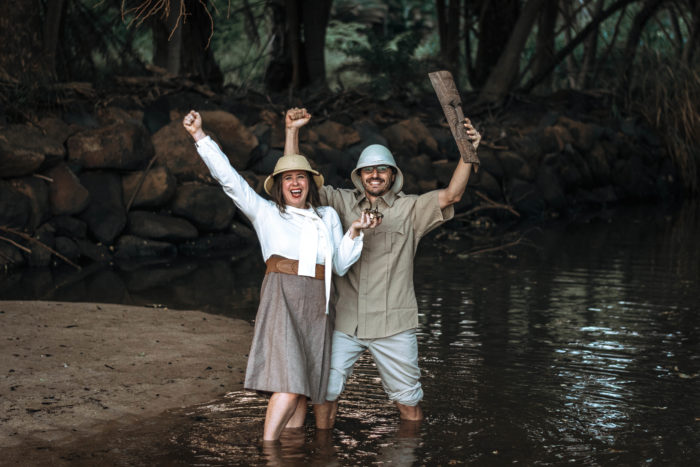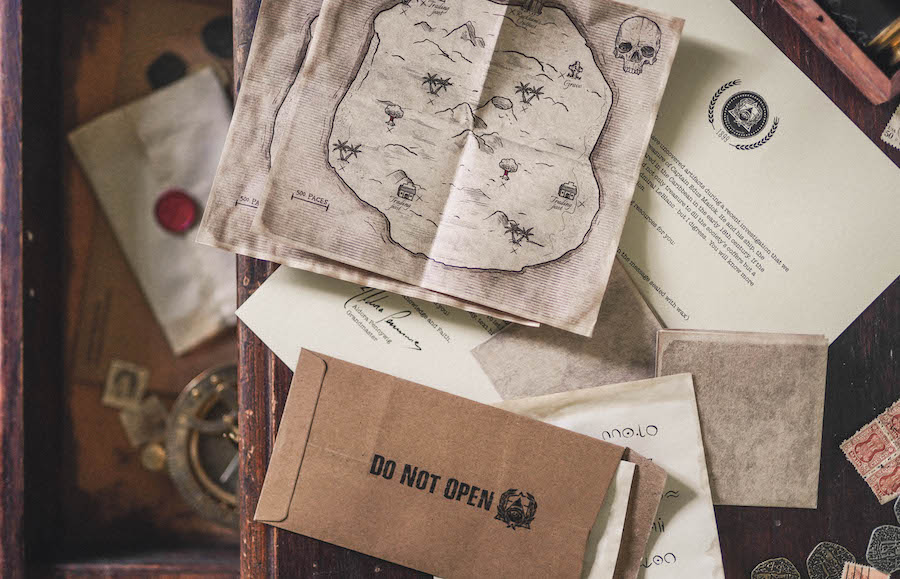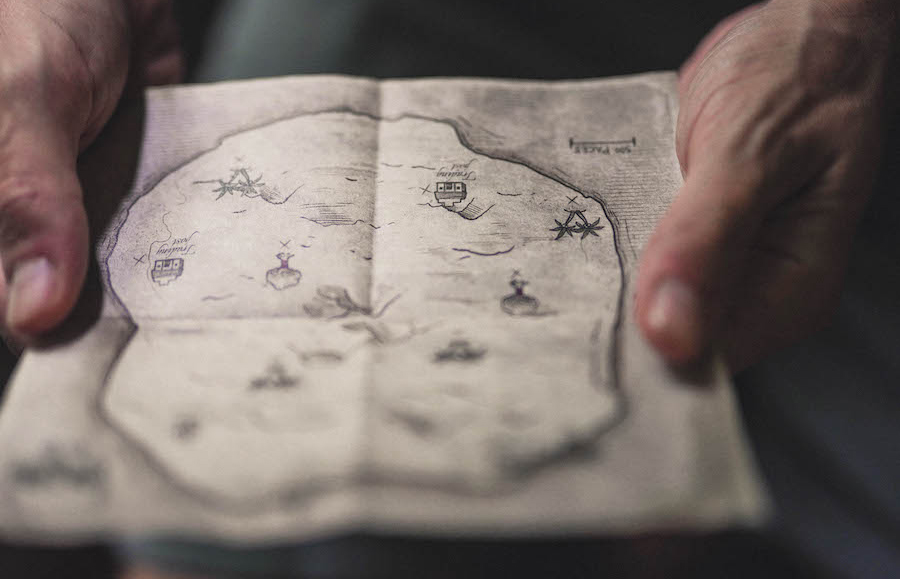The clock ticks down. You are on an escape room adventure with your friends and as you search for clues, you stumble upon a door. You open it and… You’re faced with a wall covered in a cipher—lines and lines of codes. This will take at least 10 minutes! Now: who among your friends gets the “honor”of deciphering all of it while the others open locks and enjoy countless discoveries?
We have a pretty awesome job. People pay us to have fun – to escape their normal lives and be immersed, challenged and delighted. Of course, everyone has different ideas of what is fun – and this is where the work and art of puzzle design kicks in. For example, while I personally geek out while searching a space with a black light, and most new players feel the same, a majority of long-time enthusiasts don’t anymore.
So as we design games, the question becomes: “To most players, is this fun?”
How does novelty impact fun?
1. Novelty wears off fast!
Consider this example: You find a piano in an escape room. You also hear a melody. You have to recreate the melody! You’ve never seen this in an escape room before and are completely charmed! Until…you realize there are twenty notes to figure out… And music is not your thing. The first few notes are challenging and rewarding but the puzzle feels like it never ends.

The initial delight turned into tedium as the task overstayed its welcome. This often happens with process puzzles – a puzzle where you have to apply the same process over and over – in our example, the process is determining the right note to play on a keyboard.
Thankfully, that’s easy to fix: just shorten the task! When designing puzzles, we try to determine what is a good length to keep players engaged in a novel task, but not exhausted. As we playtest, we pay close attention to players’ energy levels and modify tasks as needed.
Players’ stamina ebbs and flows throughout a game, depending on the difficulty of puzzles or the moments surrounding them. Finding the right pacing – and hitting the sweet spot of fun! – is a delicate balancing act.
2. A new angle on old classics is novel
Let’s get back to the blacklight: Experienced escape room players have seen many, many, (many!) blacklights in games. Sadly, we can’t expect the “wow moment,” they provided five years ago… BUT… What a black light reveals or how it is used can still give a novel moment. Basically, how do we take something players are used to, and surprise them all over again?
Would it be more fun to do something else?
In a non-linear escape room or experience, players are likely to divide and conquer. As we design, we will look at all puzzles and ask: are they all equally fun? Will different puzzles appeal to different types of players and the ways they think? Is any task longer than the others?
We aim to keep most puzzles around the same length of time. We also consider how many players are expected to participate in each puzzle. Lastly, we consider other puzzles that are likely to be discovered and solved at the same time, and make sure that no big moment is missed by anyone.
Is The Puzzle Frustrating or Challenging?
We never want to frustrate players, but we want to challenge our players. Overall, a game should make players feel like they worked for, and deserved the win. It’s a fine line to walk between frustrating and challenging. A great challenge pushes players just a little bit outside of their comfort zone and rewards them. A frustrating puzzle is often too hard, unfair, or requires too much time to be completed after players understand how it’s solved.
Thoughtful hints are a great way to smooth out the friction in harder puzzles. If a player just isn’t clicking with a puzzle, very granular hints can get them on the right track without taking the win – the “aha!” moment, away from the player.
In a physical escape room, Gamemasters can help nudge players towards a solution without taking away the win. The trick in this is to give clues that shift focus towards what is needed for the solve instead of explicitly telling players how to solve a puzzle.
Designing our Society of Curiosities tabletop solve-a-mystery games presents even more difficulty than escape rooms because there isn’t a live gamemaster pacing a game and we must rely on self-serve hints. We want players to know that hints are a tool, not a weakness.
Does this feel like a time killer?

So… we’ve designed a game and playtested it, but the game duration isn’t quite right – it feels just a little too short. How do we fix it? Easy – add extra steps to a puzzle. A cipher that’s a little longer. Throw in a more complex logic puzzle. How about a sudoku? Maybe not.
After watching thousands of games, we feel that although players might not be able to place their finger on it, they can tell if an escape room packs a lot of puzzling value. On average, puzzles for escape rooms are about five minutes long each. If we make a puzzle longer but it has no purpose except for filling in the time, players will feel it. We aim for puzzles that make sense in a story that focus on obtaining the “Aha moment,” with not too much to do after the “Aha.” For example, we have a few ciphers in our tabletop escape games – we aim to make them challenging to understand, but easy and fast to decode once the cipher mechanism is solved.
What’s the payoff for the effort?
The harder the puzzle, the greater the reward. In our upcoming overnight escape experience, we have a few really neat rooms to reveal. These are the big moments and because of that, we put meatier puzzles leading into them. The most effort gets the biggest payoff. In our tabletop games, we often have players open a new envelope containing new interesting items to inspect. And of course, after a challenging puzzle, we give our players a few (hopefully) easier ones to pick up momentum before the next hard one. We hope that this strategy maximizes fun and encourages effort.
Are stressors of an escape room ruining a fun puzzle?
There are puzzles that many people love, like logic puzzles, BUT things get harder when you’re watching the clock and try to concentrate through other players talking/shouting/panicking because time is running out. Part of our design process is thinking about the environment and determining if a puzzle is fun, calibrating the difficulty and duration of a puzzle to account for environmental stressors.
We had a very simple logic puzzle in our original Curse of The Tiki Lounge Game in Hawaii. It was a puzzle that most could solve in the normal world in under a minute, but when placed in the game, it took double if not triple the time to solve. Why? This logic puzzle was at the end of the game, when players feel the stress of the time crunch. The endgame music was also louder and faster, and this puzzle was also placed at a non-linear point, where players could do many things, so people were moving all over the place and talking over each other. A lot was going on!
But was it fun?
In this case, we think it was: we tweaked the puzzle to be extremely simple and it compensated for all the mayhem. Had we given players a logic puzzle that normally took five minutes in the real world, it likely would have frustrated players and caused a lackluster crawl to the end of the game.
Can I Buy This in A Puzzle Book?
There are so many amazing crossword, cryptic crossword, sudoku, and other puzzle books. (Puzzle Snacks from Eric Berlin is my favorite at the moment.) And you get so much bang for your buck! Our goal as designers is to give our players something completely different than they could get in a book.
Here’s the caveat: We are OK with putting any of these puzzles in a game IF we can present it in a novel way or if it helps the story. Bigger is not different – a big Sudoku that solves like a regular Sukoku is still a Sudoku BUT if the crossword puzzle is written by one of the characters in our story and the solve tells us more about the character or propels the plot forward, and there’s a reason for the puzzle to exist, then that is fair game.
Do We Have Fun?

Yes! We love what we do! There are moments where it’s really hard work. We have to say no to a lot of great ideas because they just don’t quite work for the game we’re working on. But watching people play or getting emails about our games (we’re talking the good emails – we are compliment fiends) makes it all worth it. We hope players can feel the care we put into our games and leave each of our experiences having had fun. And we hope you’ve enjoyed this article. Let us know what you think!


